Abstract
Coronary angiography and exercise stress tests were performed in 91 consecutive patients under 60 years of age having either no or only mild angina pectoris with or without medication after a first myocardial infarction. Nine (10%) patients had angiographic high risk coronary artery disease defined as three vessel disease, left main stenosis, or proximal stenosis of the left anterior descending artery. Eighteen patients had a positive electrocardiographic exercise stress test including eight of the nine patients with angiographic high risk coronary artery disease. It may be concluded therefore that coronary angiography to detect high risk coronary artery disease in this group can be restricted to patients with a positive exercise stress test. This policy would obviate the need for about 80% of coronary angiograms performed in this age group.
Full text
PDF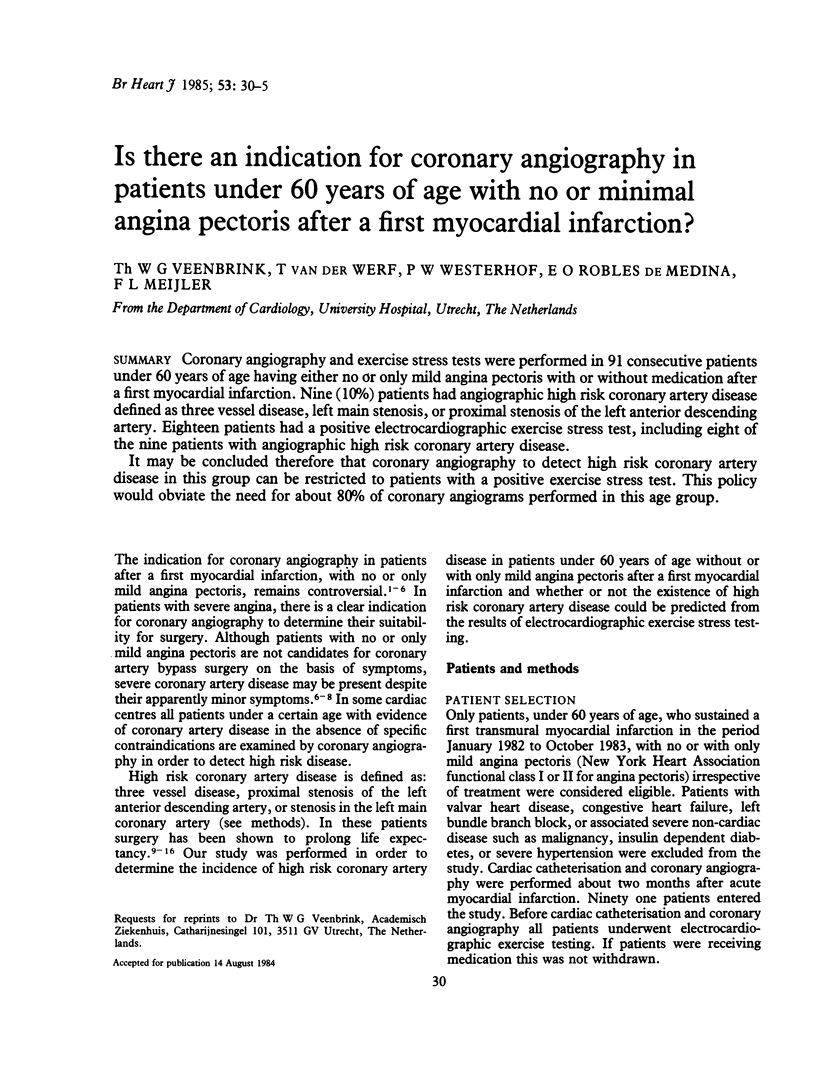
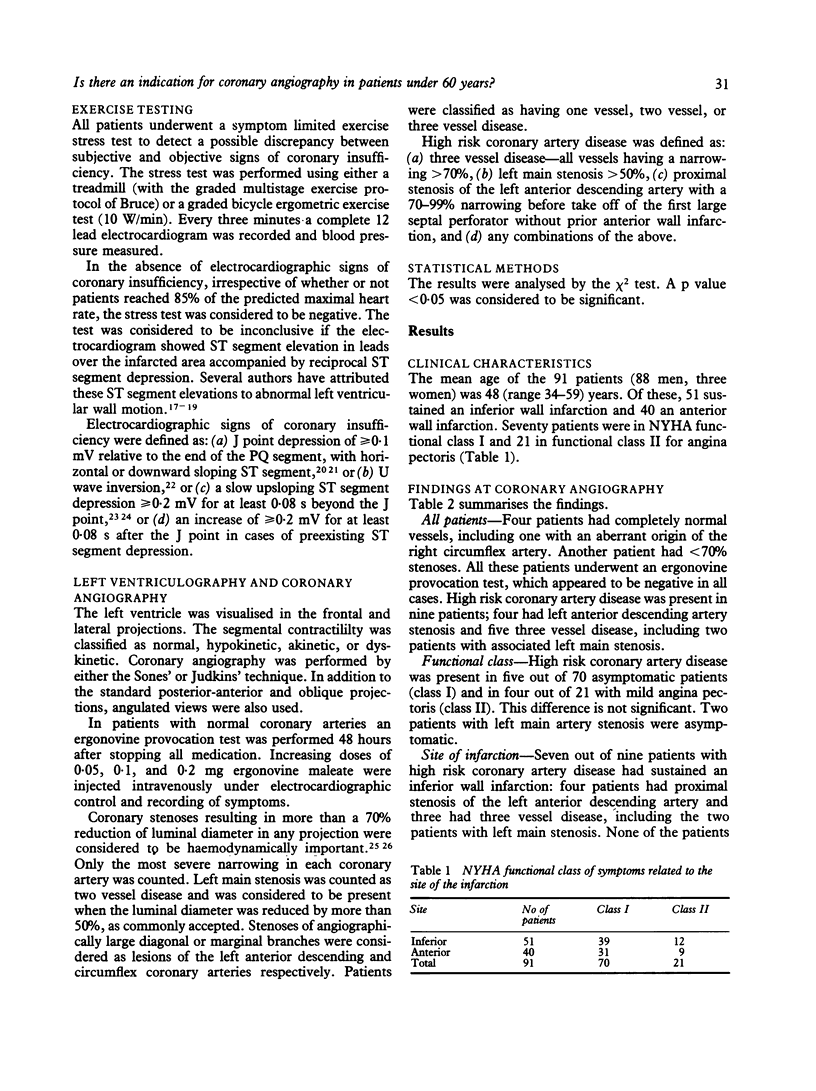
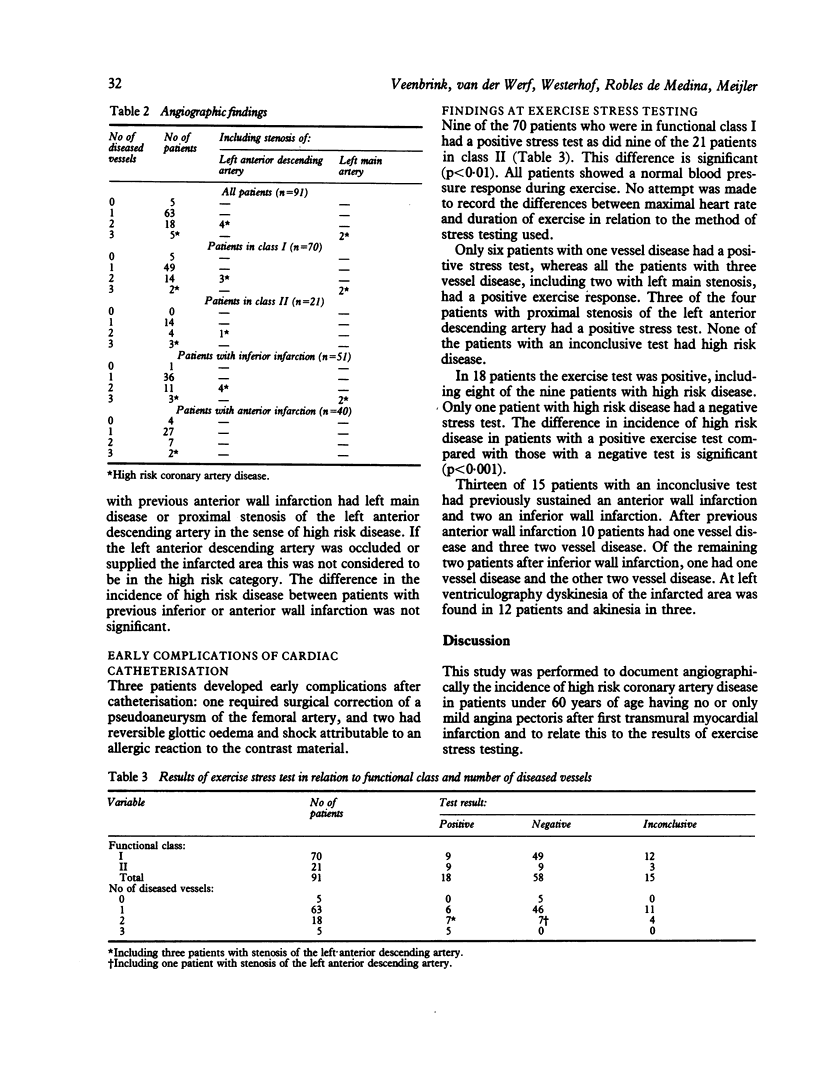
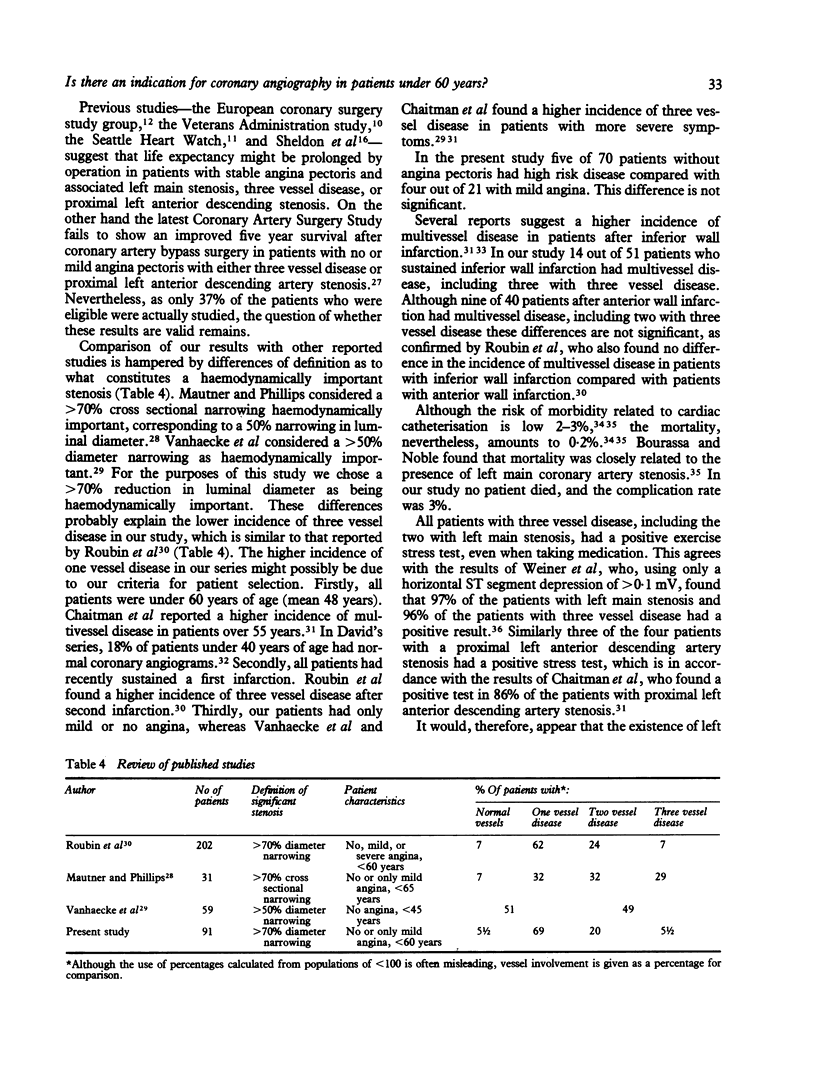
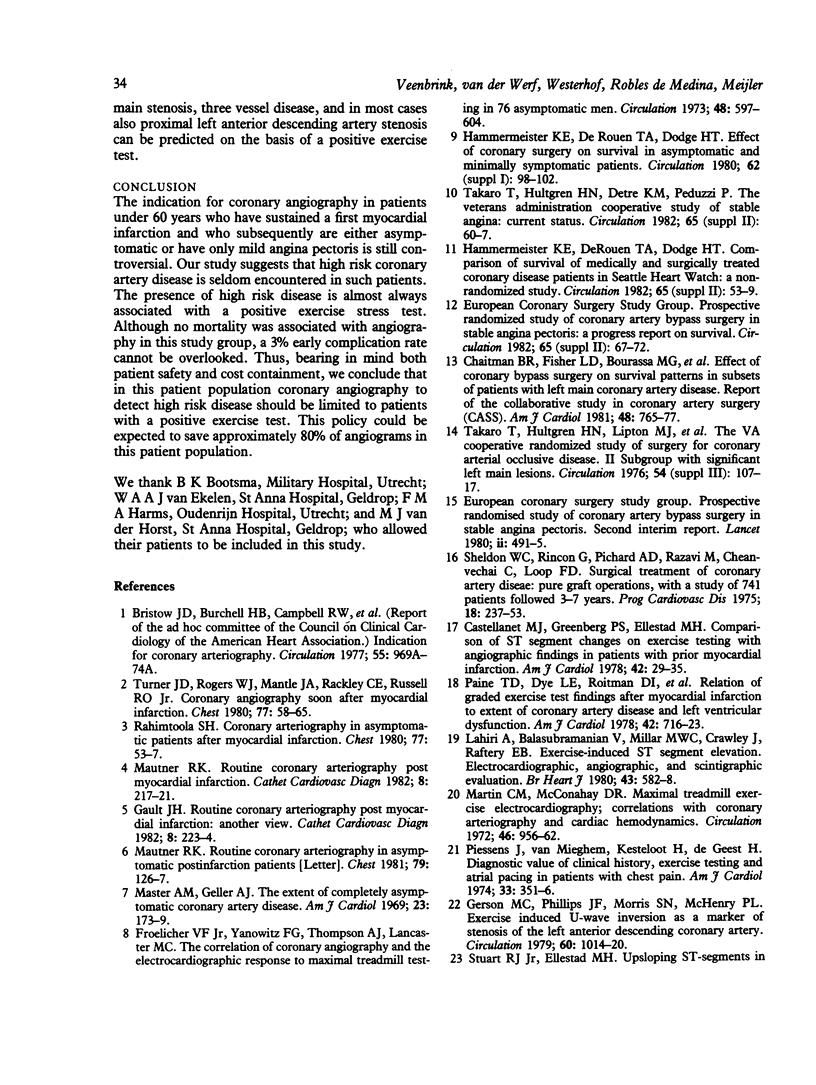
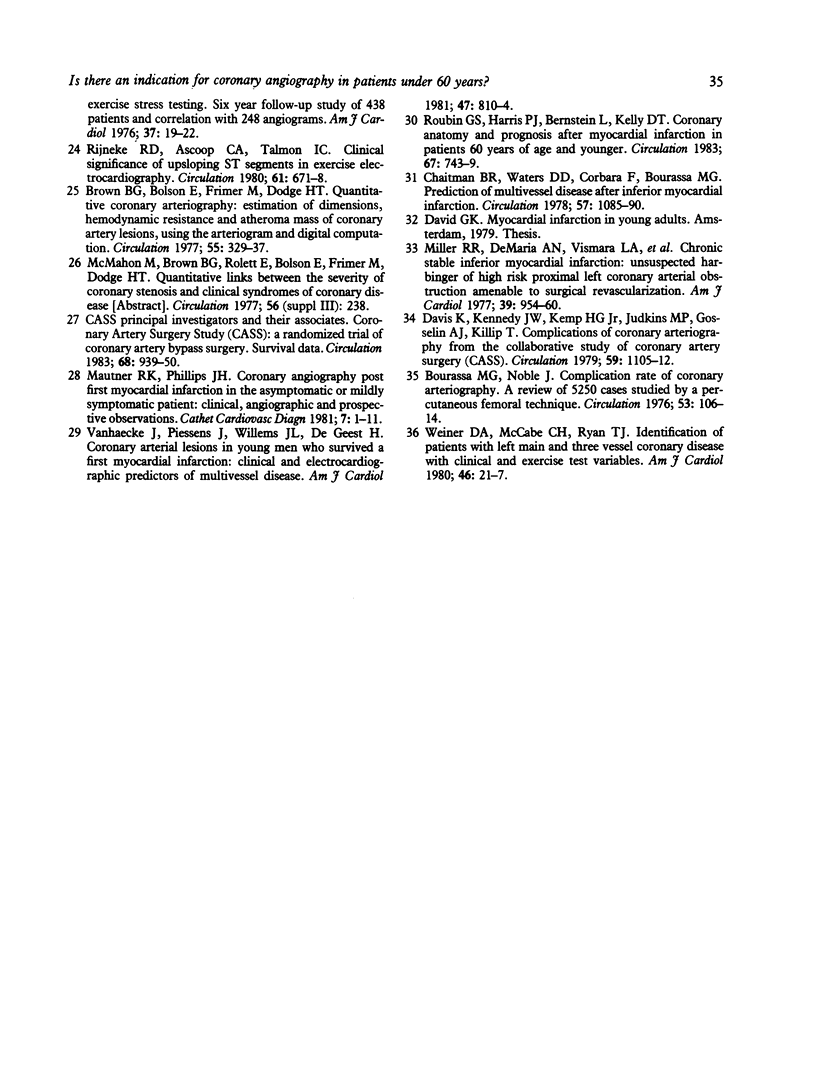
Selected References
These references are in PubMed. This may not be the complete list of references from this article.
- Bourassa M. G., Noble J. Complication rate of coronary arteriography. A review of 5250 cases studied by a percutaneous femoral technique. Circulation. 1976 Jan;53(1):106–114. doi: 10.1161/01.cir.53.1.106. [DOI] [PubMed] [Google Scholar]
- Brown B. G., Bolson E., Frimer M., Dodge H. T. Quantitative coronary arteriography: estimation of dimensions, hemodynamic resistance, and atheroma mass of coronary artery lesions using the arteriogram and digital computation. Circulation. 1977 Feb;55(2):329–337. doi: 10.1161/01.cir.55.2.329. [DOI] [PubMed] [Google Scholar]
- Castellanet M. J., Greenberg P. S., Ellestad M. H. Comparison of S-T segment changes on exercise testing with angiographic findings in patients with prior myocardial infarction. Am J Cardiol. 1978 Jul;42(1):29–35. doi: 10.1016/0002-9149(78)90980-3. [DOI] [PubMed] [Google Scholar]
- Chaitman B. R., Fisher L. D., Bourassa M. G., Davis K., Rogers W. J., Maynard C., Tyras D. H., Berger R. L., Judkins M. P., Ringqvist I. Effect of coronary bypass surgery on survival patterns in subsets of patients with left main coronary artery disease. Report of the Collaborative Study in Coronary Artery Surgery (CASS). Am J Cardiol. 1981 Oct;48(4):765–777. doi: 10.1016/0002-9149(81)90156-9. [DOI] [PubMed] [Google Scholar]
- Chaitman B. R., Waters D. D., Corbara F., Bourassa M. G. Prediction of multivessel disease after inferior myocardial infarction. Circulation. 1978 Jun;57(6):1085–1090. doi: 10.1161/01.cir.57.6.1085. [DOI] [PubMed] [Google Scholar]
- Davis K., Kennedy J. W., Kemp H. G., Jr, Judkins M. P., Gosselin A. J., Killip T. Complications of coronary arteriography from the Collaborative Study of Coronary Artery Surgery (CASS). Circulation. 1979 Jun;59(6):1105–1112. doi: 10.1161/01.cir.59.6.1105. [DOI] [PubMed] [Google Scholar]
- Froelicher V. F., Jr, Yanowitz F. G., Thompson A. J., Lancaster M. C. The correlation of coronary angiography and the electrocardiographic response to maximal treadmill testing in 76 asymptomatic men. Circulation. 1973 Sep;48(3):597–604. doi: 10.1161/01.cir.48.3.597. [DOI] [PubMed] [Google Scholar]
- Gault J. H. Routine coronary arteriography post myocardial infarction: another view. Cathet Cardiovasc Diagn. 1982;8(3):223–224. doi: 10.1002/ccd.1810080303. [DOI] [PubMed] [Google Scholar]
- Gerson M. C., Phillips J. F., Morris S. N., McHenry P. L. Exercise-induced U-wave inversion as a marker of stenosis of the left anterior descending coronary artery. Circulation. 1979 Nov;60(5):1014–1020. doi: 10.1161/01.cir.60.5.1014. [DOI] [PubMed] [Google Scholar]
- Hammermeister K. E., DeRouen T. A., Dodge H. T. Comparison of survival of medically and surgically treated coronary disease patients in Seattle Heart Watch: a nonrandomized study. Circulation. 1982 Jun;65(7 Pt 2):53–59. doi: 10.1161/01.cir.65.7.53. [DOI] [PubMed] [Google Scholar]
- Hammermeister K. E., DeRouen T. A., Dodge H. T. Effect of coronary surgery on survival in asymptomatic and minimally symptomatic patients. Circulation. 1980 Aug;62(2 Pt 2):I98–102. [PubMed] [Google Scholar]
- Lahiri A., Balasubramanian V., Millar Craig M. W., Crawley J., Raftery E. B. Exercise-induced ST segment elevation. Electrocardiographic, angiographic, and scintigraphic evaluation. Br Heart J. 1980 May;43(5):582–588. doi: 10.1136/hrt.43.5.582. [DOI] [PMC free article] [PubMed] [Google Scholar]
- Martin C. M., McConahay D. R. Maximal treadmill exercise electrocardiography. Correlations with coronary arteriography and cardiac hemodynamics. Circulation. 1972 Nov;46(5):956–962. doi: 10.1161/01.cir.46.5.956. [DOI] [PubMed] [Google Scholar]
- Master A. M., Geller A. J. The extent of completely asymptomatic coronary artery disease. Am J Cardiol. 1969 Feb;23(2):173–179. doi: 10.1016/0002-9149(69)90064-2. [DOI] [PubMed] [Google Scholar]
- Mautner R. K., Phillips J. H. Coronary angiography post first myocardial infarction in the asymptomatic or mildly symptomatic patient: clinical, angiographic, and prospective observations. Cathet Cardiovasc Diagn. 1981;7(1):1–11. doi: 10.1002/ccd.1810070102. [DOI] [PubMed] [Google Scholar]
- Mautner R. K. Routine coronary arteriography in asymptomatic postinfarction patients. Chest. 1981 Jan;79(1):126–127. doi: 10.1378/chest.79.1.126b. [DOI] [PubMed] [Google Scholar]
- Mautner R. K. Routine coronary arteriography post myocardial infarction. Cathet Cardiovasc Diagn. 1982;8(3):217–221. doi: 10.1002/ccd.1810080302. [DOI] [PubMed] [Google Scholar]
- Miller R. R., DeMaria A. N., Vismara L. A., Salel A. F., Maxwell K. S., Armsterdam E. A., Mason D. T. Chronic stable inferior myocardial infarction: unsuspected harbinger of high-risk proximal left coronary arterial obstruction amenable to surgical revascularization. Am J Cardiol. 1977 Jun;39(7):954–960. doi: 10.1016/s0002-9149(77)80207-5. [DOI] [PubMed] [Google Scholar]
- Paine T. D., Dye L. E., Roitman D. I., Sheffield L. T., Rackley C. E., Russell R. O., Jr, Rogers W. J. Relation of graded exercise test findings after myocardial infarction to extent of coronary artery disease and left ventricular dysfunction. Am J Cardiol. 1978 Nov;42(5):716–723. doi: 10.1016/0002-9149(78)90089-9. [DOI] [PubMed] [Google Scholar]
- Piessens J., Van Mieghem W., Kesteloot H., De Geest H. Diagnostic value of clinical history, exercise testing and atrial pacing in patients with chest pain. Am J Cardiol. 1974 Mar;33(3):351–356. doi: 10.1016/0002-9149(74)90315-4. [DOI] [PubMed] [Google Scholar]
- Rahimtoola S. H. Coronary arteriography in asymptomatic patients after myocardial infarction. The need to distinguish between clinical investigation and clinical care. Chest. 1980 Jan;77(1):53–57. doi: 10.1378/chest.77.1.53. [DOI] [PubMed] [Google Scholar]
- Rijneke R. D., Ascoop C. A., Talmon J. L. Clinical significance of upsloping ST segments in exercise electrocardiography. Circulation. 1980 Apr;61(4):671–678. doi: 10.1161/01.cir.61.4.671. [DOI] [PubMed] [Google Scholar]
- Roubin G. S., Harris P. J., Bernstein L., Kelly D. T. Coronary anatomy and prognosis after myocardial infarction in patients 60 years of age and younger. Circulation. 1983 Apr;67(4):743–749. doi: 10.1161/01.cir.67.4.743. [DOI] [PubMed] [Google Scholar]
- Sheldon W. C., Rincon G., Pichard A. D., Razavi M., Cheanvechai C., Loop F. D. Surgical treatment of coronary artery disease: pure graft operations, with a study of 741 patients followed 3--7 yr. Prog Cardiovasc Dis. 1975 Nov-Dec;18(3):237–253. doi: 10.1016/0033-0620(75)90013-4. [DOI] [PubMed] [Google Scholar]
- Stuart R. J., Ellestad M. H. Upsloping S-T segments in exercise stress testing. Six year follow-up study of 438 patients and correlation with 248 angiograms. Am J Cardiol. 1976 Jan;37(1):19–22. doi: 10.1016/0002-9149(76)90493-8. [DOI] [PubMed] [Google Scholar]
- Takaro T., Hultgren H. N., Detre K. M., Peduzzi P. The Veterans Administration Cooperative Study of stable angina: current status. Circulation. 1982 Jun;65(7 Pt 2):60–67. doi: 10.1161/01.cir.65.7.60. [DOI] [PubMed] [Google Scholar]
- Turner J. D., Rogers W. J., Mantle J. A., Rackley C. E., Russell R. O., Jr Coronary angiography soon after myocardial infarction. Chest. 1980 Jan;77(1):58–64. doi: 10.1378/chest.77.1.58. [DOI] [PubMed] [Google Scholar]
- Vanhaecke J., Piessens J., Willems J. L., De Geest H. Coronary arterial lesions in young men who survived a first myocardial infarction: clinical and electrocardiographic predictors of multivessel disease. Am J Cardiol. 1981 Apr;47(4):810–814. doi: 10.1016/0002-9149(81)90178-8. [DOI] [PubMed] [Google Scholar]
- Weiner D. A., McCabe C. H., Ryan T. J. Identification of patients with left main and three vessel coronary disease with clinical and exercise test variables. Am J Cardiol. 1980 Jul;46(1):21–27. doi: 10.1016/0002-9149(80)90600-1. [DOI] [PubMed] [Google Scholar]


